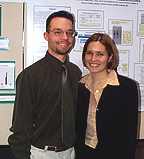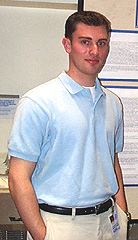
| T H E N I H C A T A L Y S T | M A Y – J U N E 2001 |
|
|
|
POSTBAC POSTER DAY:HARBINGER OF THE NIH SPRING |
text and photos by Valerie Judkins, OE
|
With posters, preceptors, and passersby crowded into the Building 10 Visitor Center reception area, 75 postbaccalaureate students presented their wares April 4 at the second annual postbaccalaurate poster session—officially signaling that this, indeed, will be an annual event.
Sponsored by the Office of Education, it was also the first display of the research done by postbacs in the inaugural class of the NIH Academy (see "The NIH Academy: Up and Running . . . , The NIH Catalyst, January–February 2001).
Recent college graduates who come to NIH to eat and breathe biomedical research for a year or two, many postbacs have deferred graduate or medical school to take advantage of what NIH has to offer; others—whose research interests are confirmed as they labor in an NIH lab—begin the postgraduate application process while in the throes of the program here.
In interviews with The Catalyst during poster day, some postbacs expressed astonishment at how much they had accomplished in a year’s worth of full-time research. "It’s really adding up," said Carlos Gonzalez, whose research, along with that of just a few of the other 74 postbacs who presented posters, is highlighted below.
 |
|
Jessica
Diggs
|
Perifosine, a Novel Alkylphospho-lipid, Blocks Cell Cycle Progression by Transcriptional Activation of p21waf1/cip1
Jessica Diggs says her interest in health disparities led her to work in the lab of Adrian Senderowicz in the Oral and Pharyngeal Cancer Branch of NIDCR.
Her research there focuses on perifosine, an alkylphospholipid that may be an important factor in controlling cell-cycle progression in head and neck cancers by activating p21waf1/cip1, a protein that inhibits cyclin-dependent kinases.
"These cancers are often fatal and can be disfiguring for those who survive," says Diggs.
According to NIDCR data, there are about 40,000 new cases and 12,000 deaths from head and neck cancers each year. These cancers also disproportionately affect ethnic minorities and those of lower socioeconomic status.
"My research and NIH Academy activities I’ve participated in have greatly increased my understanding of health disparities," said Diggs, adding that African-American males have the highest incidence and mortality of head and neck cancers.
Diggs first came to NIH as a participant in the NIAID Introduction to Biomedical Research Program while she was an undergraduate at Carlow College in Pittsburgh. After graduation, she chose to return to NIH as a member of the first class of the NIH Academy, a postbac program specifically dedicated to the elimination of health disparities.
This year Diggs will attend Case Western Reserve University School of Medicine, Cleveland, where she will pursue an M.D./Ph.D. in health services research.
Pathophysiology of Ground-glass Hepatocytes
Carlos Gonzalez’s research is focused on ground-glass hepatocytes (GGH), a unique histological feature of chronic hepatitis B (HBV) infection.
His findings suggest that retention of a mutant form of the HBV PreS1 protein within the ER-Golgi intermediate space—either through abnormal folding or a lack of interaction with ER chaperone proteins—underlies GGH.
 |
|
Carlos
Gonalzez and Vanessa Muniz-Medina are married to one another but work
in different NIH labs.
|
Gonzalez graduated from the University of Puerto Rico, Rio Piedras. He came to NIH, with his wife, Vanessa Muniz-Medina (also a postbac—see below). Gonzalez says he transported his family to Bethesda because, "I honestly could not imagine a better place to get experience and insight into the world of biomedical research."
Although he did research in several labs as an undergraduate, he says nothing can compare to his experience at NIH.
"Working in the lab is very intense. There’s always an experiment to do, results to review. . . . it’s very fast paced."
He described his lab, headed by Jake Liang, in the Digestive Diseases Branch of NIDDK, as "a close-knit effort to understand the pathology of hepatitis B and C viruses."
It pleases him to think that the research he’s done in a year here may contribute to the development of effective treatments of HBV infection—all the while he is gaining invaluable experience that he believes is preparing him for graduate studies.
Vascular Endothelial Growth Factor
Vanessa Muniz-Medina’s research is concentrated on the study of vascular endothelial growth factor (VEGF), which she described as a small, soluble protein that transfers information regulating cellular growth.
Controlled growth factor release occurs when tissues are deprived of adequate oxygen. Cells in such a tissue will respond by releasing VEGF, which stimulates other nearby cells that specialize in constructing blood vessels.
Muniz-Medina’s lab, headed by Carl Baker, chief of the Cellular Regulation and Transformation Section in the NCI Basic Research Laboratory, is also interested in the study of the human papillomavirus (HPV). The goal in this study is to correlate the expression of the different VEGF isoforms with cancer tumors and with lesions caused by HPV.
With this correlation, the investigators hope to identify which isoform(s) are present in the most aggressive cancers. Muniz-Medina believes this information could play a major role in treatment monitoring and prognosis.
While she was an undergraduate at the University of Puerto Rico, Muniz-Medina had four years of lab experience in four different labs. But her experience here, she said, has also been more intense.
"In addition to my research, Dr. Baker is already preparing me for graduate school. He assigns readings and interviews me every day about what I’m learning."
She mentioned that she also "learned a lot about the human body and diseases" through attending six surgeries performed by Erik Kass, chief of clinical otolaryngology, head and neck surgery branch, NIDCD, and an autopsy performed by Baker.
She expects to complete an M.D./Ph.D. program and have a career in teaching and research. "With the graduate school preparation I am receiving at NIH, I am well on my way," she said.
 |
|
Matthew
Steinway
|
The Determination of Variances in Exhaled Nitric Oxide Output in Normal Healthy Male Volunteers Consuming High and Low Nitrate/Nitrite Diets
Matthew Steinway has spent the year involved in clinical research in the lab of Joel Moss in the NHLBI Pulmonary-Critical Care Medicine Branch.
His research is a pilot study designed to determine whether dietary intake influences exhaled nitric oxide (NO) levels.
NO has been recognized for its multifaceted roles in such physiological processes as vasodilatation, host defense, neurotransmission, bronchodilation, and inflammation. Study results should allow researchers to determine the most effective method of monitoring nitric oxide synthase activity and could also aid in identifying activities responsible for maintaining nitric oxide levels.
Steinway recently graduated from the University of Michigan, Ann Arbor, and plans to attend medical school after he completes his research at NIH.
He was attracted to NIH,
he said, because he had been involved in a "good amount of basic science
research" during his undergraduate years and wanted to experience a "different
view of biomedical research" that would be just as challenging—namely,
clinical research. NIH, he said, "offers some of the best opportunities
in clinical research." ![]()